Drops Of A Liquid Can Often Join A Pool Gradually Through A Process Known As The Coalescence Cascade


Drops of a liquid can often join a pool gradually through a process known as the coalescence cascade (top left). In this process, a drop sits atop a pool, separated by a thin air layer. Once that air drains out, contact is made and part of the drop coalesces. Then a smaller daughter droplet rebounds and the process repeats.
A recent study describes a related phenomenon (top right) in which the coalescence cascade is drastically sped up through the use of surfactants. The normal cascade depends strongly on the amount of time it takes for the air layer between the drop and pool to drain. By making the pool a liquid with a much greater surface tension value than the drop, the researchers sped up the air layer’s drainage. The mismatch in surface tension between the drop and pool creates an outward flow on the surface (below) due to the Marangoni effect. As the pool’s liquid moves outward, it drags air with it, thereby draining the separating layer more quickly. The result is still a coalescence cascade but one in which the later stages have no rebound and coalesce quickly. (Image and research credit: S. Shim and H. Stone, source)

More Posts from Evisno and Others

Zeta Ophiuchus
A massive star plowing through the gas and dust floating in space. Zeta Oph is a bruiser, with 20 times the Sun’s mass. It’s an incredibly luminous star, blasting out light at a rate 80,000 times higher than the Sun! Even at its distance of 400 light years or so, it should be one of the brightest stars in the sky … yet it actually appears relatively dim to the eye.
Credit: NASA/Hubble
If it is just us, seems like an awful waste of space.
Carl Sagan (from Contact)

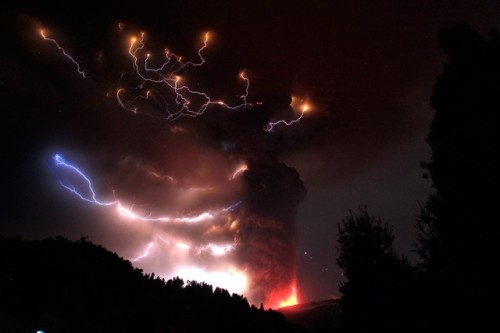

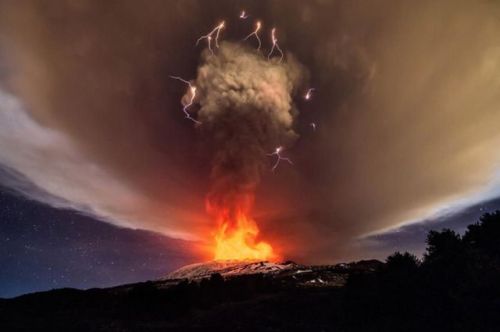
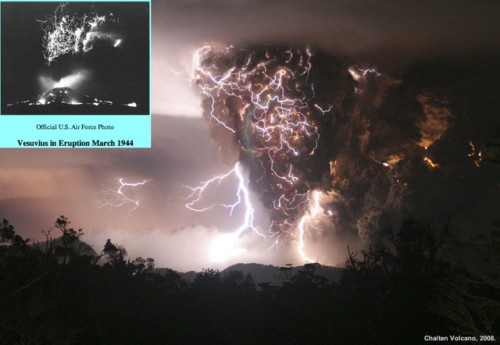

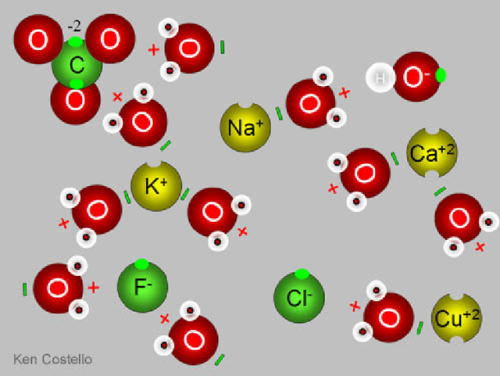

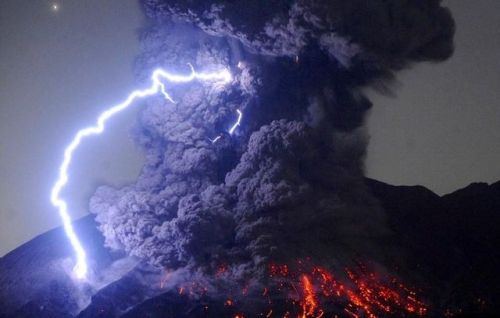
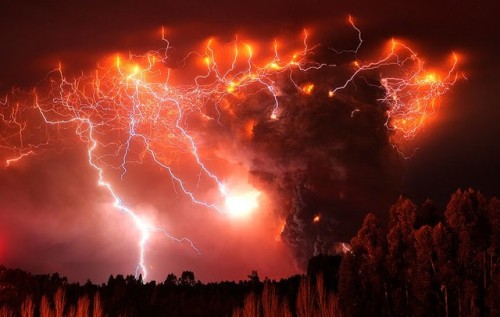
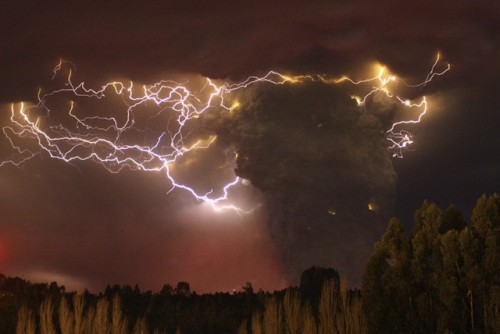
How Do Volcanoes Make Lightning?
“Volcanic lightning appears to occur most frequently around volcanoes with large ash plumes, particularly during active stages of the eruption, where flowing, molten lava creates the largest temperature gradients. The phenomena of lightning has been exquisitely recorded around a number of recent volcanic eruptions, including Iceland’s Eyjafjallajökull, Japan’s Sakurajima, Italy’s Mt. Etna, and Chile’s Puyehue, Calbuco and Chaiten volcanoes. But what you may not know is this phenomenon was not only captured during Mt. Vesuvius’ last eruption in 1944, but was accurately described nearly 2,000 years ago when it erupted all the way back in the year 79!”
Volcanoes are some of the most potentially destructive natural phenomena known to occur on our world. The most violent eruptions feature not only lava, but soot, ash, volatile gases, and even enormous chunks of rock hurled great distances. What you might not realize, however, is just how frequently these eruptions are accompanied by another spectacular show: volcanic lightning. Lightning isn’t only found in thunderstorms or other great electrical discharges between the clouds and the ground, but is produced in volcanic eruptions all throughout the world, and throughout history as well. After countless generations, where we wondered what could produce such an unusual but spectacular show, we’ve finally figured it out.
Come get the science behind how volcanoes make lightning, and enjoy some of the greatest photographs of this phenomena humanity’s ever taken!
Why Bennu?
Our OSIRIS-REx spacecraft will travel to a near-Earth asteroid, called Bennu, where it will collect a sample to bring back to Earth for study.
But why was Bennu chosen as the target destination asteroid for OSIRIS-REx? The science team took into account three criteria: accessibility, size and composition.

Accessibility: We need an asteroid that we can easily travel to, retrieve a sample from and return to Earth, all within a few years time. The closest asteroids are called near-Earth objects and they travel within 1.3 Astronomical Units (AU) of the sun. For those of you who don’t think in astronomical units…one Astronomical Unit is approximately equal to the distance between the sun and the Earth: ~93 million miles.

For a mission like OSIRIS-REx, the most accessible asteroids are somewhere between 0.08 – 1.6 AU. But we also needed to make sure that those asteroids have a similar orbit to Earth. Bennu fit this criteria! Check!
Size: We need an asteroid the right size to perform two critical portions of the mission: operations close to the asteroid and the actual sample collection from the surface of the asteroid. Bennu is roughly spherical and has a rotation period of 4.3 hours, which is in our size criteria. Check!

Composition: Asteroids are categorized by their spectral properties. In the visible and infrared light minerals have unique signatures or colors, much like fingerprints. Scientists use these fingerprints to identify molecules, like organics. For primitive, carbon-rich asteroids like Bennu, materials are preserved from over 4.5 billion years ago! We’re talking about the start of the formation of our solar system here! These primitive materials could contain organic molecules that may be the precursors to life here on Earth, or elsewhere in our solar system.

Thanks to telescopic observations in the visible and the infrared, as well as in radar, Bennu is currently the best understood asteroid not yet visited by a spacecraft.
All of these things make Bennu a fascinating and accessible asteroid for the OSIRIS-REx mission.
Make sure to follow us on Tumblr for your regular dose of space: http://nasa.tumblr.com
Solar System: Things to Know This Week
Learn the latest on Cassini’s Grand Finale, Pluto, Hubble Space Telescope and the Red Planet.
1. Cassini’s Grand Finale

After more than 12 years at Saturn, our Cassini mission has entered the final year of its epic voyage to the giant planet and its family of moons. But the journey isn’t over. The upcoming months will be like a whole new mission, with lots of new science and a truly thrilling ride in the unexplored space near the rings. Later this year, the spacecraft will fly repeatedly just outside the rings, capturing the closest views ever. Then, it will actually orbit inside the gap between the rings and the planet’s cloud tops.
Get details on Cassini’s final mission
The von Kármán Lecture Series: 2016
2. Chandra X-Rays Pluto

As the New Horizon’s mission headed to Pluto, our Chandra X-Ray Observatory made the first detection of the planet in X-rays. Chandra’s observations offer new insight into the space environment surrounding the largest and best-known object in the solar system’s outermost regions.
See Pluto’s X-Ray
3. … And Then Pluto Painted the Town Red

When the cameras on our approaching New Horizons spacecraft first spotted the large reddish polar region on Pluto’s largest moon, Charon, mission scientists knew two things: they’d never seen anything like it before, and they couldn’t wait to get the story behind it. After analyzing the images and other data that New Horizons has sent back from its July 2015 flight through the Pluto system, scientists think they’ve solved the mystery. Charon’s polar coloring comes from Pluto itself—as methane gas that escapes from Pluto’s atmosphere and becomes trapped by the moon’s gravity and freezes to the cold, icy surface at Charon’s pole.
Get the details
4. Pretty as a Postcard

The famed red-rock deserts of the American Southwest and recent images of Mars bear a striking similarity. New color images returned by our Curiosity Mars rover reveal the layered geologic past of the Red Planet in stunning detail.
More images
5. Things Fall Apart

Our Hubble Space Telescope recently observed a comet breaking apart. In a series of images taken over a three-day span in January 2016, Hubble captured images of 25 building-size blocks made of a mixture of ice and dust drifting away from the comet. The resulting debris is now scattered along a 3,000-mile-long trail, larger than the width of the continental U.S.
Learn more
Discover the full list of 10 things to know about our solar system this week HERE.
Make sure to follow us on Tumblr for your regular dose of space: http://nasa.tumblr.com

I believe in free education, one that’s available to everyone; no matter their race, gender, age, wealth, etc… This masterpost was created for every knowledge hungry individual out there. I hope it will serve you well. Enjoy!
FREE ONLINE COURSES (here are listed websites that provide huge variety of courses)
Alison
Coursera
FutureLearn
open2study
Khan Academy
edX
P2P U
Academic Earth
iversity
Stanford Online
MIT Open Courseware
Open Yale Courses
BBC Learning
OpenLearn
Carnegie Mellon University OLI
University of Reddit
Saylor
IDEAS, INSPIRATION & NEWS (websites which deliver educational content meant to entertain you and stimulate your brain)
TED
FORA
Big Think
99u
BBC Future
Seriously Amazing
How Stuff Works
Discovery News
National Geographic
Science News
Popular Science
IFLScience
YouTube Edu
NewScientist
DIY & HOW-TO’S (Don’t know how to do that? Want to learn how to do it yourself? Here are some great websites.)
wikiHow
Wonder How To
instructables
eHow
Howcast
MAKE
Do it yourself
FREE TEXTBOOKS & E-BOOKS
OpenStax CNX
Open Textbooks
Bookboon
Textbook Revolution
E-books Directory
FullBooks
Books Should Be Free
Classic Reader
Read Print
Project Gutenberg
AudioBooks For Free
LibriVox
Poem Hunter
Bartleby
MIT Classics
Many Books
Open Textbooks BCcampus
Open Textbook Library
WikiBooks
SCIENTIFIC ARTICLES & JOURNALS
Directory of Open Access Journals
Scitable
PLOS
Wiley Open Access
Springer Open
Oxford Open
Elsevier Open Access
ArXiv
Open Access Library
LEARN:
1. LANGUAGES
Duolingo
BBC Languages
Learn A Language
101languages
Memrise
Livemocha
Foreign Services Institute
My Languages
Surface Languages
Lingualia
OmniGlot
OpenCulture’s Language links
2. COMPUTER SCIENCE & PROGRAMMING
Codecademy
Programmr
GA Dash
CodeHS
w3schools
Code Avengers
Codelearn
The Code Player
Code School
Code.org
Programming Motherf*?$%#
Bento
Bucky’s room
WiBit
Learn Code the Hard Way
Mozilla Developer Network
Microsoft Virtual Academy
3. YOGA & MEDITATION
Learning Yoga
Learn Meditation
Yome
Free Meditation
Online Meditation
Do Yoga With Me
Yoga Learning Center
4. PHOTOGRAPHY & FILMMAKING
Exposure Guide
The Bastards Book of Photography
Cambridge in Color
Best Photo Lessons
Photography Course
Production Now
nyvs
Learn About Film
Film School Online
5. DRAWING & PAINTING
Enliighten
Ctrl+Paint
ArtGraphica
Google Cultural Institute
Drawspace
DragoArt
WetCanvas
6. INSTRUMENTS & MUSIC THEORY
Music Theory
Teoria
Music Theory Videos
Furmanczyk Academy of Music
Dave Conservatoire
Petrucci Music Library
Justin Guitar
Guitar Lessons
Piano Lessons
Zebra Keys
Play Bass Now
7. OTHER UNCATEGORIZED SKILLS
Investopedia
The Chess Website
Chesscademy
Chess.com
Spreeder
ReadSpeeder
First Aid for Free
First Aid Web
NHS Choices
Wolfram Demonstrations Project
Please feel free to add more learning focused websites.
*There are a lot more learning websites out there, but I picked the ones that are, as far as I’m aware, completely free and in my opinion the best/ most useful.




The latest from Brock Davis - love his work!
NASA logo. April 27, 2015 As the saying goes, timing is everything. More so in 21st-century space exploration where navigating spacecraft precisely to far-flung destinations—say to Mars or even more distant Europa, a moon of Jupiter—is critical. NASA is making great strides...



All the times science fiction became fact
I don’t usually go for these really-big-ads-disguised-as-infographics (Really? Sci-fi ink & toner?), but this one was too cool to pass up.
Unfortunately, no hoverboards yet. But we’ve still got 15 months before time runs out on that one:
Bonus: Why are some science fiction authors so good at predicting the future? Check out this episode of It’s Okay To Be Smart where I talk all about that:
(via io9)
-
 techjum reblogged this · 4 years ago
techjum reblogged this · 4 years ago -
 longlivetherebelking reblogged this · 4 years ago
longlivetherebelking reblogged this · 4 years ago -
 longlivetherebelking liked this · 4 years ago
longlivetherebelking liked this · 4 years ago -
 unova-state-of-mind liked this · 4 years ago
unova-state-of-mind liked this · 4 years ago -
 ittybittypyro liked this · 4 years ago
ittybittypyro liked this · 4 years ago -
 percjyackson reblogged this · 4 years ago
percjyackson reblogged this · 4 years ago -
 shreeeebs liked this · 4 years ago
shreeeebs liked this · 4 years ago -
 muy-gron reblogged this · 4 years ago
muy-gron reblogged this · 4 years ago -
 badbitchkyoshi reblogged this · 4 years ago
badbitchkyoshi reblogged this · 4 years ago -
 badbitchkyoshi liked this · 4 years ago
badbitchkyoshi liked this · 4 years ago -
 dykeosaurusrhi reblogged this · 4 years ago
dykeosaurusrhi reblogged this · 4 years ago -
 dykeosaurusrhi liked this · 4 years ago
dykeosaurusrhi liked this · 4 years ago -
 gohansparkles liked this · 4 years ago
gohansparkles liked this · 4 years ago -
 sooothisisawkward liked this · 4 years ago
sooothisisawkward liked this · 4 years ago -
 nostalgicproteinbag liked this · 4 years ago
nostalgicproteinbag liked this · 4 years ago -
 dragons134678 liked this · 4 years ago
dragons134678 liked this · 4 years ago -
 riptidepercys liked this · 4 years ago
riptidepercys liked this · 4 years ago -
 neverlandbrat reblogged this · 4 years ago
neverlandbrat reblogged this · 4 years ago -
 normalpersonn reblogged this · 4 years ago
normalpersonn reblogged this · 4 years ago -
 normalpersonn liked this · 4 years ago
normalpersonn liked this · 4 years ago -
 trevoristhemandarin liked this · 4 years ago
trevoristhemandarin liked this · 4 years ago -
 bigbowlofselfconsciencepudding reblogged this · 4 years ago
bigbowlofselfconsciencepudding reblogged this · 4 years ago -
 bigbowlofselfconsciencepudding liked this · 4 years ago
bigbowlofselfconsciencepudding liked this · 4 years ago -
 srbobtacos liked this · 4 years ago
srbobtacos liked this · 4 years ago -
 imdoingwhatiwant reblogged this · 4 years ago
imdoingwhatiwant reblogged this · 4 years ago -
 abysmsovereign reblogged this · 4 years ago
abysmsovereign reblogged this · 4 years ago -
 giogio-gzg reblogged this · 4 years ago
giogio-gzg reblogged this · 4 years ago -
 giogio-gzg liked this · 4 years ago
giogio-gzg liked this · 4 years ago -
 grilledkatniss reblogged this · 4 years ago
grilledkatniss reblogged this · 4 years ago -
 junior-freeze liked this · 4 years ago
junior-freeze liked this · 4 years ago -
 grilledkatniss liked this · 4 years ago
grilledkatniss liked this · 4 years ago -
 vorejuiceguzzler reblogged this · 4 years ago
vorejuiceguzzler reblogged this · 4 years ago -
 vorejuiceguzzler liked this · 4 years ago
vorejuiceguzzler liked this · 4 years ago -
 percjyackson liked this · 4 years ago
percjyackson liked this · 4 years ago -
 roarlikeawolf liked this · 4 years ago
roarlikeawolf liked this · 4 years ago -
 againstpollutions liked this · 4 years ago
againstpollutions liked this · 4 years ago -
 infreidel liked this · 4 years ago
infreidel liked this · 4 years ago -
 annabethshadow reblogged this · 4 years ago
annabethshadow reblogged this · 4 years ago -
 nikitajackson liked this · 4 years ago
nikitajackson liked this · 4 years ago -
 luckyxfinn reblogged this · 4 years ago
luckyxfinn reblogged this · 4 years ago -
 luckyxfinn liked this · 4 years ago
luckyxfinn liked this · 4 years ago -
 takebadger liked this · 4 years ago
takebadger liked this · 4 years ago -
 j-lee-ty liked this · 4 years ago
j-lee-ty liked this · 4 years ago -
 thepoledancerfromreno liked this · 4 years ago
thepoledancerfromreno liked this · 4 years ago -
 angelofcolours liked this · 4 years ago
angelofcolours liked this · 4 years ago -
 derpypig31 reblogged this · 4 years ago
derpypig31 reblogged this · 4 years ago -
 derpypig31 liked this · 4 years ago
derpypig31 liked this · 4 years ago -
 thetitancurse reblogged this · 4 years ago
thetitancurse reblogged this · 4 years ago



